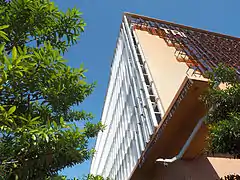Translational Research Institute (Australia)
The Translational Research Institute (TRI) is Australia's first translational medical research institute dedicated to translating scientific discoveries into applications for medical practice.[1]
 The Translational Research Institute | |
| Founder(s) | Professor Ian Frazer AC |
|---|---|
| Established | October 2013 |
| Mission | Medical research |
| Focus | Translational |
| Chief Executive Officer | Scott Bell |
| Faculty | |
| Adjunct faculty | Brisbane Diamantina Health Partners |
| Staff | 800 |
| Location | Kent Street, Woolloongabba , , , |
| Coordinates | 27.499101°S 153.031221°E |
| Website | www |
Located in Woolloongabba, in inner-city Brisbane, Queensland, TRI is supported by a grant from the Australian Government ($140 million); and funding from the Queensland Government ($107 million); Queensland University of Technology ($25 million); and The University of Queensland ($10 million)[2] to combine clinical and translational research to advance progress from laboratory discovery to application in patient care.[3][4] TRI is a Pty Ltd. company with four shareholders: Queensland Health,[5] the Queensland University of Technology,[6] The University of Queensland[7] and Mater Medical Research.[8]
History
In 2004 a proposal was submitted to the Queensland Government for the development and construction of TRI. In 2007 this progressed to project design.[9] Five years on and A$354 million in funding from the Australian and Queensland Governments, UQ and QUT, TRI became operational and four institutes came together. TRI was established in January 2013 and officially opened in October of the same year by the Governor-General Dame Quentin Bryce.[10]
Research
Over 800 researchers and clinicians from TRI’s four shareholders undertake medical research and clinical studies into cancer; inflammation and infection; obesity and diabetes; kidney disease and liver disease; and bone and joint disorders.[3]
TRI research aims to:
Researchers
Some of TRI's researchers include:
- Professor Ian Frazer - known for the development of the HPV vaccine against cervical cancer.
- Associate Professor Glenda Gobe - Co-director, renal atrophy and regeneration, fibrosis, immunity and inflammation, and kidney cancer.
- Professor Carolyn Mountford - former TRI CEO, known for magnetic resonance spectroscopic imaging.
- Professor Judith Clements - known for Kallikrein proteases in prostate and ovarian cancers.
- Professor Josephine Forbes - specialises in the study of glycation and diabetes.
- Professor David Johnson – known for kidney treatments and transplants.
- Professor Pamela Russell - known for specialising in immunology and subsequently, in prostate and bladder cancer research.
- Professor Scott Bell - Current TRI CEO, renowned respiratory specialist.
Facilities
Located on the Princess Alexandra (PA) Hospital campus, the seven-story TRI building incorporates four floors of laboratories; and facilities for research support, administration and teaching.
TRI’s core facilities[11] include:
- Clinical Research Facilities
- Cytometry Core Facility
- Histology Core Facility
- Microscopy Core Facility
- Proteomics Facility
Co-located with TRI are the following facilities:
- Patheon Biologics,[12] the first major biopharmaceutical manufacturing facility in Australia.
- The Pharmacy Australian Centre of Excellence (PACE) [13]
- Brisbane Diamantina Health Partners, an academic health science system
The TRI building
The TRI building was designed by Wilson Architects + Donovan Hill and was built by Watpac, completed in 2012 at the total cost of $354 million.[14] The facility features eight levels: four levels of laboratories, administration and teaching facilities, an auditorium and conference rooms, staff amenities and an "outdoor room" atrium area. TRI is a 32,000 square metres (340,000 sq ft) building. It stands on the grounds of the Princess Alexandra Hospital in Brisbane on the former site of the Vision Australia building, of which the red clay bricks were salvaged and reused as the base of TRI.[15]
The building received several architectural and design awards.[16][17][18]
See also
References
- "Construction begins on Australia's first Translational Research Institute". Australian Trade Commission. Australian Government. Retrieved 16 August 2014.
- "TRI Story". The University of Queensland. Retrieved 12 March 2017.
- "TRI Story". The Translational Research Institute. Retrieved 12 March 2017.
- "TRI Story". The University of Queensland. Retrieved 16 August 2014.
- "Translational Research Institute". Queensland Government. Retrieved 16 August 2014.
- "QUT Research Centres, Programs and Laboratories". Queensland University of Technology. Retrieved 16 August 2014.
- "UQ TRI". The University of Queensland. Retrieved 12 March 2017.
- "Mater Research - TRI". Mater Research. Retrieved 12 March 2017.
- "Translational Research Institute Facility". Translational Research Institute. Retrieved 12 March 2017.
- "Official opening of the translational research institute". Governor General of the Commonwealth of Australia. Retrieved 16 August 2014.
- "TRI Facilities". The Translational Research Institute. Retrieved 12 March 2017.
- "Patheon Sites". Patheon Biologics. Retrieved 12 March 2017.
- "PACE". University of Queensland. Retrieved 12 March 2017.
- "A state-of-the-art facility". Translational Research Institute. Retrieved 7 January 2015.
- "Translational Research Institute". ArchitectureAU. Retrieved 1 January 2015.
- "Master Builders: Project of the Year". Master Builders. Retrieved 16 August 2014.
- "Master Builders: Construction Awards". Master Builders. Retrieved 16 August 2014.
- "Queensland Awards: State Architecture Awards". Australian Institute of Architects. Retrieved 16 August 2014.